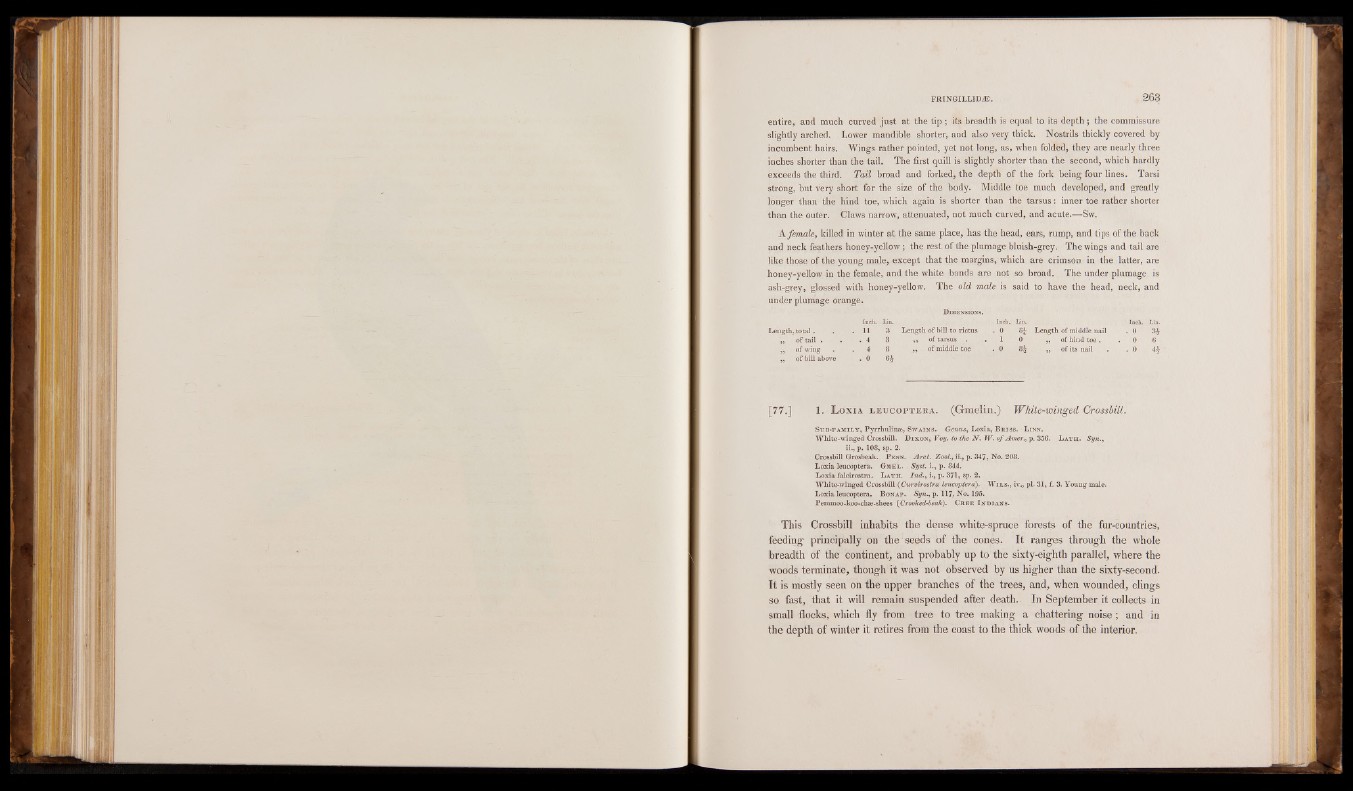
FRINGILLIDjE . 263
entire, and much curved just at the tip ; its breadth is equal to its depth; the commissure
slightly arched. Lower mandible shorter, and also very thick. Nostrils thickly covered by
incumbent hairs. Wings rather pointed, yet not long, as, when folded, they are nearly three
inches shorter than the tail. The first quill is slightly shorter than the second, which hardly
exceeds the third. Tail broad and forked, the depth of the fork being four lines. Tarsi
strong, but very short for the size of the body. Middle toe much developed, and greatly
longer than the hind toe, which again is shorter than the tarsus: inner toe rather shorter
than the outer. Claws narrow, attenuated, not much curved, and acute.—Sw.
A female, killed in winter at the same place, has the head, ears, rump, and tips of the back
and neck feathers honey-yellow ; the rest of the plumage bluish-grey. The wings and tail are
like those of the young male, except that the margins, which are crimson in the latter, are
honey-yellow in the female, and the white bands are not so broad. The under plumage is
ash-grey, glossed with honey-yellow. The old male is said to have the head, neck, and
under plumage orange.
D im en s io n s.
Inch. Lin. Inch, Lin. ' Inch. Lin.
Length, total. . 11 3 Length of bill to rictus . 0 8£ Length of middle nail . 0 3.£
„ o f ta il . . . 4 3 „ of tarsus . . 1 0 „ of hind toe . 0 6
„ of wing . 4 8 „ of middle toe . 0 8£ . ' „ of its nail . 0 4i
„ of bill above . 0 l §
[77.] 1. L oxia leucoptera. (Gmelin.) White-winged Crossbill.
Sub-family, Pyrrhulinae, Sw a in s. Genus, Loxia, Briss. L inn.
White-winged Crossbill. D ix o n , Voy. to the N . W. of Amer., p. 356. Lath. Syn.,
ii., p. 108, sp. 2.
Crossbill Grosbeak. P enn. Arct. Zool., ii., p; 347, No. 208.
Loxia leucoptera. Gm e l . Syst. i., p. 844.
Loxia falcirostra. Lath. Ind., i., p. 371, sp. 2.
White-winged Crossbill (Curvirostra leucoptera). Wils., iv., pi. 31, f. 3. Young male.
Loxia leucoptera. Bonap. Syn., p. 117, No. 195.
Pemmoo-koo-cbae-sbees (Crooked-beak). Cb.e e I n d ia n s.
This Crossbill inhabits the dense white-spruce forests of the fur-countries,
feeding principally on the seeds of the cones. It ranges through the whole
breadth of the continent, and probably up to the sixty-eighth parallel, where the
woods terminate, though it was not observed by us higher than the sixty-second.
It is mostly seen on the upper branches of the trees, and, when wounded, clings
so fast, that it will remain suspended after death. In September it collects in
small flocks, which fly from tree to tree making a chattering noise; and in
the depth of winter it retires from the coast to the thick woods of the interior.